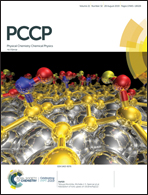Cost-effective density functional theory (DFT) calculations of equilibrium isotopic fractionation in large organic molecules†
Abstract
The application of stable isotopes to address a wide range of biochemical, microbiological and environmental problems is hindered by the experimental difficulty and the computational cost of determining equilibrium isotopic fractionations (EIF) of large organic molecules. Here, we evaluate the factors that impact the accuracy of computed EIFs and develop a framework for cost-effective and accurate computation of EIFs by density functional theory (DFT). We generated two benchmark databases of experimentally determined EIFs, one for H isotopes and another for the isotopes of the heavy atoms C, N and O. The accuracy of several DFT exchange–correlation functionals in calculating EIFs was then evaluated by comparing the computational results to these experimental datasets. We find that with the def2-TZVP basis set, O3LYP had the lowest mean absolute deviation (21‰ and 3.9‰ for the isotopic fractionation of H and the heavier atoms, respectively), but the GGA/meta-GGA functionals τHCTHD3BJ, τHCTH and HCTH have similar performances (22‰ and 4.1‰, respectively, for τHCTHD3BJ). Leveraging the good performance of computationally efficient functionals, we provide a robust, practical, experimentally validated framework for using DFT to accurately predict EIFs of large organic molecules, including uncertainty estimates.

- This article is part of the themed collection: 2019 PCCP HOT Articles


 Please wait while we load your content...
Please wait while we load your content...